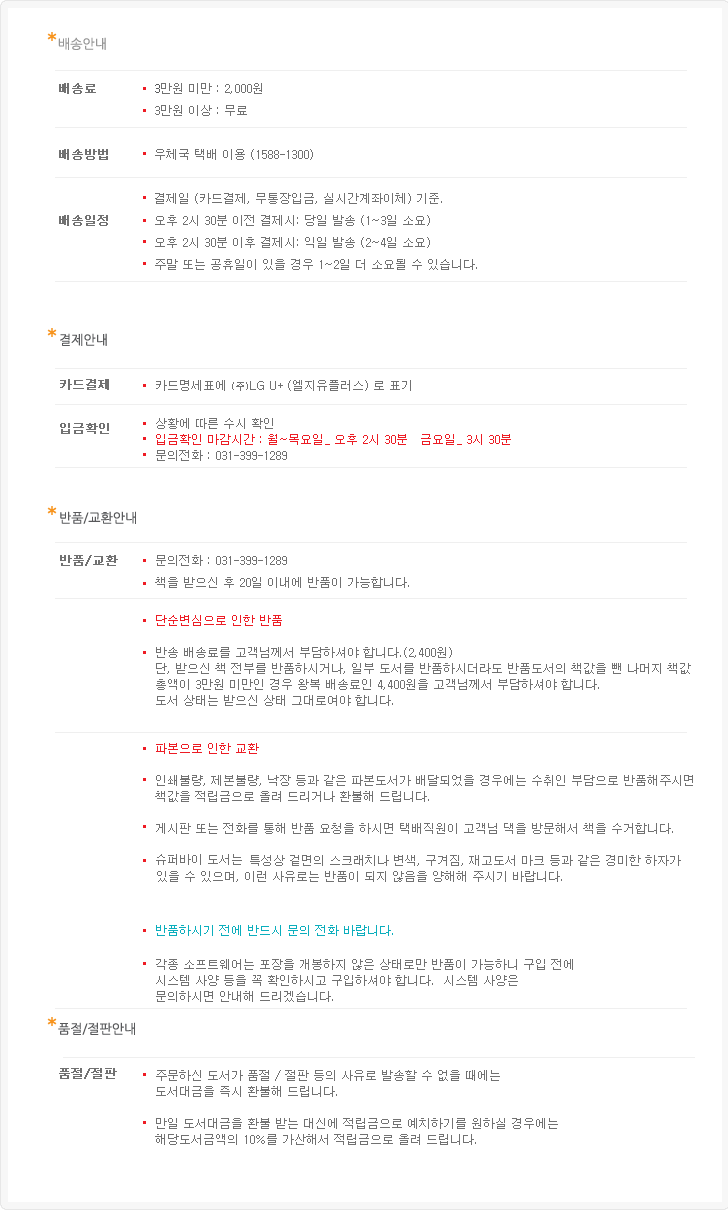|
|
|
|
|
|
|

| 최근 이 책을 구매하신 다른 회원의 책장 |
|
 |
|
|
|
[ 책 소개 ]
첫 페이지를 넘기면 수탉의 빨간 볏이 등장하고 다음 페이지에는 수탉 전체의 모습 -> 다음페이지에는 수탉을 바라보는 아이들의 모습 -> 아이들이 있는 시골농장의 모습... 이런 식으로 하나의 장면이 다음 페이지에서는 일부 장면이 되는 독특한 Zoom-out되는 그림들이 이어집니다. 마지막 장면은 지구가 우주 속의 조그만 점이 되지요.
문장이 없는 Wordless Book이며, 아이디어가 독특한 책입니다. 뒷 페이지부터 보면 점차 확대되어가는 장면을 볼 수 있습니다. 어린 아이들 뿐만 아니라 어른들도 재미있게 볼 수 있는 책입니다.
[ 서지 정보 ]
Edition: Paperback, 64 pages
ISBN-10: 0140557741
ISBN-13: 978-0140557749
책 크기 : 22.5cm x 18.4cm
[ 영문 서평 ]
Book Description
A unique and groundbreaking picture book offers compelling illustrations that, without words, create a world full of nuances and details, full of striking tableaus that seem to transform before your eyes.
From Publishers Weekly
This provocative wordless volume can be "read" either from front to back or even from back to front. Either way, it's a startling experience. Its illustrations "zoom" out, as though a viewer has rapidly backed away from each. For example, the first painting, of a jagged-edged red shape, turns out to be a detail of a rooster's comb; as the pages turn, the bird diminishes in importance, until the barn where he stands is shown to be a toy on a magazine's cover. That magazine dangles from the hand of a dozing boy, who himself becomes but a smudge on an advertising billboard. These shifts in perspective repeat until the book abandons earth altogether. The last image is a tiny white sphere-our planet-against a night sky. The bold color and level of detail in Banyai's cartoons recall "Prince Valiant" or another of the "realistic" Sunday comics. If the concept is not wholly new, the execution is superior. Readers are in for a perpetually surprising-and even philosophical-adventure. All ages.
From Booklist
Beginning with a close-up of a rooster's comb, each picture zooms out to give a more distant perspective; for example, the "camera" zooms out to show increasingly distant figures of children watching the rooster. Then, a large hand appears, showing that the scene was not depicting a real farm, but a toy farm set. But zoom out a few more times, and the scene reveals that the picture of the girl playing with the farm set is really on the magazine held by a boy, who's sleeping in a chair, which is by a pool, which is on an ocean liner, which is out at sea--no, wait--that picture is on a cruise-line poster on the side of a city bus, but that picture is on a television screen in the Arizona desert . . . and so on until the earth is shown from above, growing smaller with each turn of the page. The final scene is one white dot on a black page. Clear-cut paintings outlined in ink appear on each right-hand page; the left-hand pages are black. Not a story, but an "idea" book, it makes the viewer ask, "What am I really seeing here?" This clever picture book could be intriguing or irritating, depending on the viewer's frame of mind, but children will find it worth a look.
From School Library Journal
This wordless picture book re-creates the effect of a camera lens zooming out. For example, one illustration shows a boy on a cruise ship, the next shows him from a distance, and the next reveals the whole ship. Finally, the viewpoint moves back farther and it turns out that the ship is actually a poster on a bus. The perspective continues to recede, revealing the bus as an image on a television screen. Three pages later, viewers see that the person watching TV is drawn on a postage stamp. The final picture shows a view of Earth from space. To heighten the effect, all of the full-color illustrations appear on the recto, while each verso is completely black. It's fun to watch the transition in perceptions as a farm becomes a toy, the girl playing with it is on a magazine cover, etc. The novelty soon wears off, however, and nothing else about the book is memorable. The paintings themselves are not particularly interesting and would not stand alone well. David Wiesner's Free Fall (Lothrop, 1988), David Macaulay's Black and White (Houghton, 1990), and Ann Jonas's Reflections (Greenwillow, 1987) use visual tricks, but also have richer artwork and more involving action. |
|
|
|
|
 |
제품상제정보 배송/반품/교환 안내 |
|
|
|
Super Buy 도서는 미국 출판사의 재고도서(Remainder Book), 초과출간도서(Excess Inventory), 할인도서(Bargain Books)
등을 직수입해서 정가의 55%~80%를 할인한 가격에 판매하는 제품입니다.
Super Buy 책의 품질은 거의 새 책과 같은
수준이지만, 간혹 커버의 스크래치나 접힘과 같은 하자나, 책 하단의 재고도서 마크가 있을 수 있습니다.
저렴하게 판매하는 Super Buy 제품의 특성상 반품이 되지 않습니다만, 파본인 경우에는 착불로 반품하시면 책값을
환불해드리거나 적립금으로 올려드립니다. (반품 전에 연락 요망)
하프프라이스북에서는 중고도서(second hand book)를 취급하지 않습니다.
|
|
|
 - 등록된 128,139건의 서평이 있습니다. - 등록된 128,139건의 서평이 있습니다.
| 더보기 
|
|
|
|
|
|
|
 |
|
|
|
|
|
|